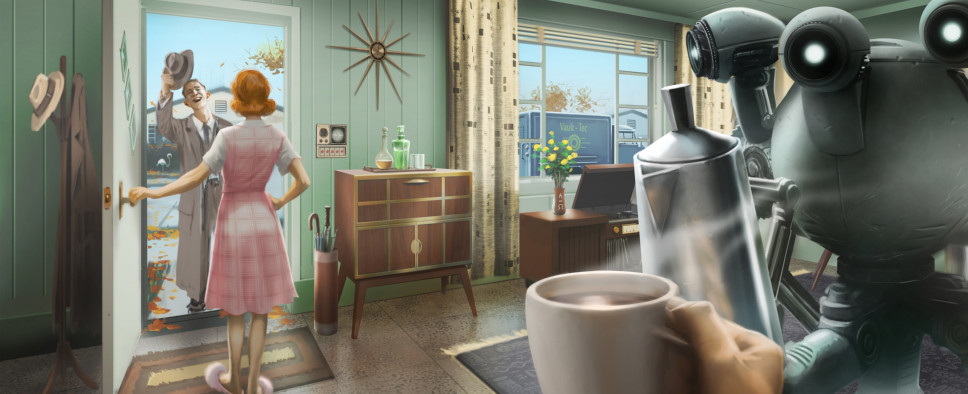The Making of Fallout 4
-
Category: News ArchiveHits: 1954

GameInformer has published a lengthy six-page feature on the making of Fallout 4, with interviews and anecdotes from some of the game's leads, like game director Todd Howard, lead artist Istvan Pely, and lead designer and writer Emil Pagliarulo, a native Bostonian who took the opportunity to insert his house and high schools into the game. As for why Boston was selected as the game's core city, here's a snippet directly from the article:
(We were talking about changing the setting from something else we were thinking about,) he says. (We were like, '˜This is probably not going to work.' We kept talking after lunch, in the hallway, in the elevators, like a West Wing walk-and-talk, and ended up in front of Istvan's office. We were just standing there talking. Istvan was at his desk, Todd was standing next to him, and I was in the corner letting them talk it out, because I could see they were going towards Boston. They started talking about the map and getting excited, and I was like '˜No f---ing way! No f---ing way!' Todd eventually turns to me and goes '˜I assume this is okay with you?')
With the destination agreed upon, the concept team traveled to Boston for a weekend to take photos and soak up the vibe of the city. (They came right back and started drawing like crazy,) Pely says. But the team learned early on that Boston didn't fit into Fallout's traditional visual framework as well as Washington, D.C., did.
The elements of Boston that the art team latched onto were mostly historical in origin the colonial side of the city. The problem was the Boston skyline of today is dominated with contemporary buildings. Most of these structures were built decades after the point Fallout's timeline diverges with ours. That challenged the art to team think of what a Boston of tomorrow would look like if it were designed with a retro/futuristic aesthetic.
(We're always trying to stay true to this franchise, and part of the challenge is we had a lot of freedom there creatively,) Pely says. (We had to figure out what the skyscrapers look like in our universe, and also hone in on the contrast of recognizable elements with futuristic stuff. It's a very eclectic mix. I think it's a pretty fresh take on a science-fiction city.)
Interestingly, the development team members ported The Elder Scrolls V: Skyrim to Xbox One to familiarize themselves with the hardware. While I doubt this version could be released as is, I'd say that this could give Bethesda a headstart if they ever decide to do a remastered version of Skyrim. That said, according to Todd Howard we shouldn't get our hopes up just yet:
The transition to Sony and Microsoft's new hardware went relatively smooth for the Fallout 4 team. Both hardware manufacturers clued Bethesda in on their plans early, and were in constant communication with the team as development began. Knowing they didn't have to worry about hitting the launches for both systems also helped. In the previous generations, both The Elder Scrolls: Morrowind and Oblivion were targeted as launch titles. The fastest way for the team to learn about the new machines was to collect data while using them. With most of Fallout 4 existing in art and on paper at this point, the team's solution was something that will likely make fans freak out.
(The first thing we did was port Skyrim to Xbox One. Don't get your hopes up yet,) Howard says with a smile. (We moved all of our data over to the system to learn it faster, and we realized we needed a new renderer. We started rewriting it for Fallout 4 in 2012. To do the amount of dynamic lighting we wanted to do, we knew we needed to have a deferred renderer. It's kind of the popular way of doing rendering now. We spent a while on that.)
Overall, I highly recommend reading the full piece to those of you who are interested in the game or the franchise. It offers a lot of insight into Bethesda's thought processes and development ethos,

